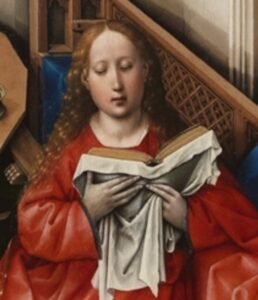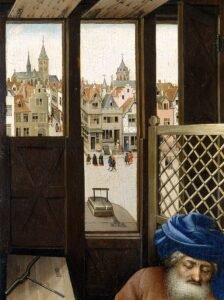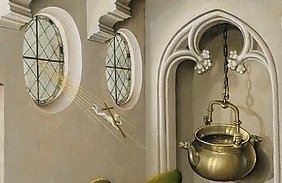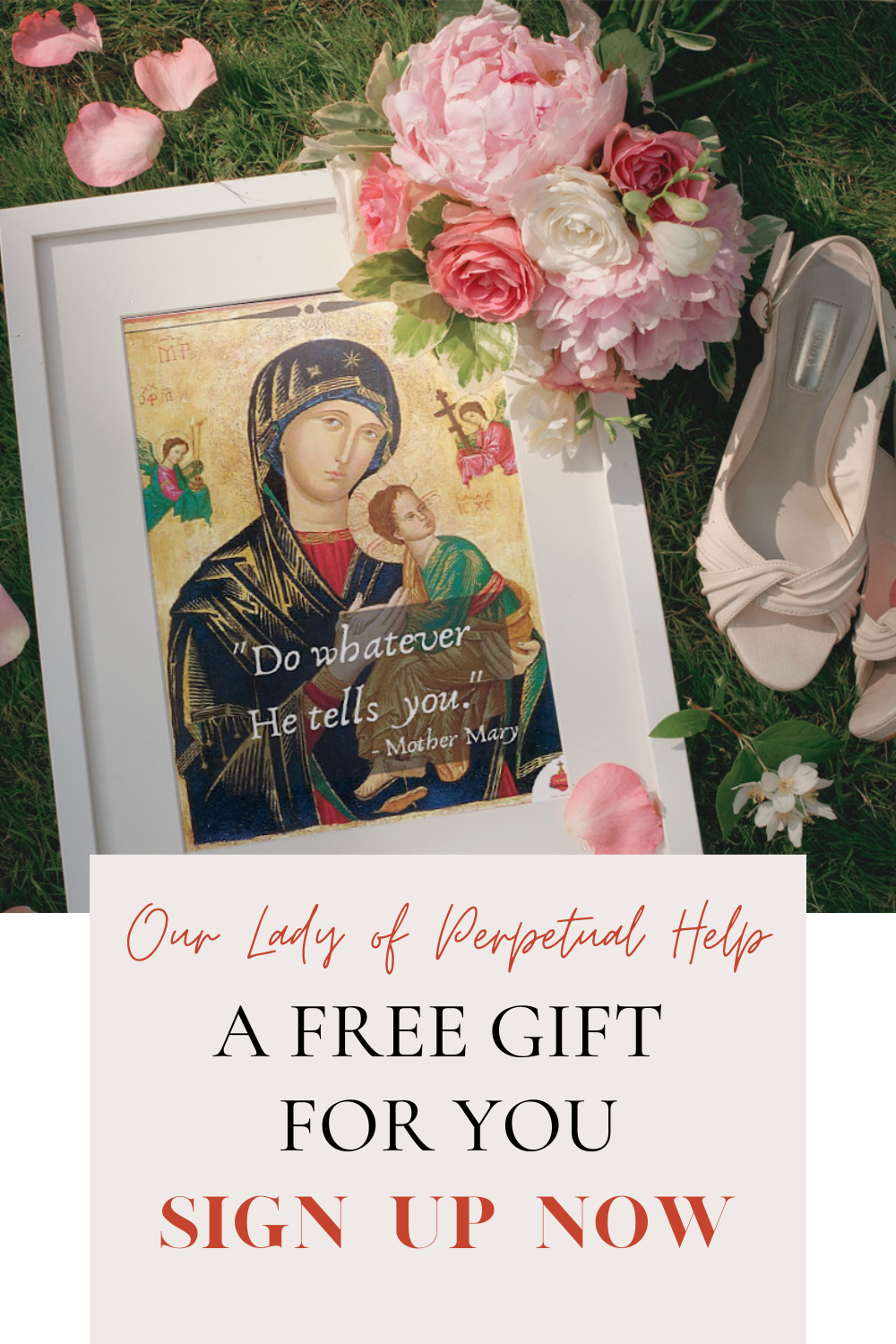10 Facts Unveiling the Beauty of “The Annunciation Triptych”: A Masterpiece of Renaissance Art
The Annunciation Triptych is a masterpiece of medieval art that continues to inspire and captivate viewers centuries after it was created. The Annunciation Triptych is a stunning work of art that tells the story of the Annunciation, a pivotal moment in Christian theology when the angel Gabriel announces to Mary that she will bear the son of God. In this blog post, we will delve into the history of this remarkable painting and many fascinating details about it.

What is the meaning of Annunciation Triptych painting?
The Annunciation Triptych is a painting that depicts the biblical story of the Annunciation, where the Angel Gabriel appears to the Virgin Mary and tells her that she will give birth to the Son of God. The painting was created in the early 15th century by the Flemish artist Robert Campin, also known as the Master of Flémalle.
This triptych was painted in the city of Tournai, which is located in modern-day Belgium. It was commissioned by an unknown patron, but it is believed that it may have been made for a private chapel or as a devotional work for a wealthy patron.
One of the fascinating aspects of this painting is the symbolism used by Campin to convey the story of the Annunciation. The lilies in the vase on the table symbolize Mary’s purity, while the pot of water represents her humility. The dove in the upper left panel is a symbol of the Holy Spirit, while the fruit on the table symbolizes the Eucharist.
Many art historians have debated whether or not the Annunciation Triptych contains a skull. Some believe that there is a skull hidden in the shadows of the right panel, while others argue that it is simply a play of light and shadow.
The painting includes several figures, including the Angel Gabriel, the Virgin Mary, and a small figure of God the Father in the upper center panel. The use of light and shadow creates a sense of depth and realism, making the figures seem to come alive on the canvas.
The Annunciation Triptych is currently housed in the Cloisters Museum in New York City, which is part of the Metropolitan Museum of Art. If you want to see this stunning work of art in person, you can plan a trip to New York City and visit the museum.
In our next section, we will give you some tips on how to plan a trip to see the Annunciation Triptych and make the most out of your visit.
When was The Annunciation Triptych made?
The Annunciation Triptych was created in the early 15th century by the Flemish artist Robert Campin, also known as the Master of Flémalle. The exact date of the painting’s creation is unknown, but it is believed to have been painted around 1427-1432.

Where Was the Annunciation Triptych Painted?
The Annunciation Triptych was painted in the early 15th century by the Flemish artist Jan van Eyck. It is believed to have been created in his workshop in Bruges, which was one of the most important artistic centers of the time.
The triptych is a classic example of the Flemish tradition of painting in oil on wood panels. This technique allowed the artist to create works of incredible richness and depth, with a level of detail that was unprecedented at the time. The Annunciation Triptych is a perfect example of this, with its intricate detailing of the figures, the architecture, and the landscapes that surround them.
The triptych consists of three panels, each of which is about 20 inches high and 12 inches wide. The central panel depicts the scene of the Annunciation, with the Archangel Gabriel appearing to Mary to announce that she has been chosen to bear the Son of God. On either side of this central panel are two smaller panels, each of which shows a donor kneeling in prayer before a depiction of a saint. The left panel shows the donor Joos Vijd and his wife, while the right panel shows the Archangel Michael and St. Catherine of Alexandria.
Who Commissioned the Annunciation Triptych?
The Annunciation Triptych was commissioned by Joos Vijd, a wealthy Flemish merchant and politician, and his wife. The couple commissioned the triptych as a religious work of art to be displayed in the Church of St. Michael in Ghent.
Vijd was a powerful figure in Ghent, and he and his wife were both devout Catholics. They wanted to commission a work of art that would not only be a testament to their faith but also a symbol of their power and status in the city.
Jan van Eyck was already well known as a painter of exceptional talent, and he was the obvious choice for the commission. Van Eyck had already completed a number of important works for the church, including the Ghent Altarpiece, which is widely considered to be one of the greatest works of art in history.

The Annunciation Triptych is a true masterpiece of Flemish art, and it is one of the most important religious works of art ever created. Its beauty and complexity are a testament to the skill and talent of Jan van Eyck, and it continues to inspire awe and wonder in all who see it.
The triptych is a vivid reminder of the power of art to inspire, to educate, and to touch the human soul. Its intricate details and rich colors transport us back to a time when faith and art were intimately intertwined, and when the beauty of the natural world was seen as a reflection of the divine.
The Annunciation Triptych is a treasure that we should all be grateful to have in our cultural heritage, and it is a reminder of the power of art to connect us with the past and inspire us to create a better future.
What was the Annunciation Triptych Made For?
The Annunciation Triptych was created as a private devotional piece for the wealthy merchant Peter Engelbrecht and his wife. The triptych was designed to be hung in their private chapel, where they could pray and meditate in the presence of the holy figures depicted on the panels.
The central panel of the triptych depicts the Annunciation, with the Angel Gabriel appearing to the Virgin Mary to announce that she has been chosen to bear the Son of God. On either side of the central panel are two smaller panels that show the donors, Peter Engelbrecht and his wife, kneeling in prayer before the holy figures of St. Joseph and St. Margaret.
The Annunciation Triptych is a wonderful example of the religious devotion and artistic talent that flourished in the 15th century. The rich symbolism and intricate detailing of the triptych are a testament to the skill and creativity of Robert Campin, and the piece remains a powerful example of the spiritual and cultural heritage of Europe.
Which of the Following are Symbols of Purity in Robert Campin’s Annunciation Triptych?
The Annunciation Triptych is rich in symbolism and iconography, and many of the images and motifs in the painting hold deep spiritual and cultural significance. One of the key themes of the triptych is the concept of purity, which is represented in a number of ways throughout the piece.
One of the most striking symbols of purity in the Annunciation Triptych is the lily, which is traditionally associated with the Virgin
Hello there, dear reader! Today, we’re going to delve into the captivating world of art and explore one of the most remarkable pieces of art that the world has ever seen. The focus of our discussion will be on “The Annunciation Triptych” – a stunning piece of art that has enthralled millions of people for centuries.

Let’s begin our exploration with a question that has been asked time and time again: does “The Annunciation Triptych” have a skull in it? Well, the answer is both yes and no. You see, “The Annunciation Triptych” is actually a collection of three different panels or sections, with each section depicting a different scene from the biblical story of the Annunciation. The skull, however, is only present in one of the panels – the panel on the far right, which is titled “The Virgin and Child with Saints and Donors”.
Moving on to our next point of discussion, let’s take a closer look at who is depicted in “The Annunciation Triptych”. As mentioned earlier, this piece of art is divided into three panels, with each panel depicting a different scene from the biblical story of the Annunciation. The panel on the left, titled “The Annunciation”, depicts the moment when the angel Gabriel visits Mary and tells her that she has been chosen to bear the son of God. In this panel, we see Mary sitting on a bench, with her hands clasped in prayer, as the angel Gabriel appears before her.

The panel in the center of the triptych, titled “The Visitation”, depicts the moment when Mary visits her cousin Elizabeth, who is also pregnant with a child. In this panel, we see Mary and Elizabeth embracing each other as they share in the joy of their pregnancies.The panel on the far right, titled “The Virgin and Child with Saints and Donors”, depicts the Virgin Mary holding the infant Jesus in her arms, surrounded by a group of saints and donors. In this panel, we see a skull at the feet of one of the saints – a reminder of the fleeting nature of life and the inevitability of death.
“The Annunciation Triptych” is a breathtaking piece of art that has captured the imagination of people for centuries. From the intricate details in each panel to the symbolism hidden within, this triptych is a true masterpiece. And while the presence of a skull in one of the panels may be jarring for some, it serves as a reminder of the impermanence of life and the importance of cherishing every moment that we have.
Where is The Annunciation Triptych?
“The Annunciation Triptych” is located in the breathtaking Uffizi Gallery in Florence, Italy. The Uffizi Gallery is one of the most famous art museums in the world, known for its extensive collection of Renaissance art, including works by Michelangelo, Botticelli, and Raphael.

How to make a trip to see the Annunciation Triptych
Now that we know where “The Annunciation Triptych” is located, let’s talk about how to make a trip to see it. The first step is to plan your trip to Florence. Florence is a beautiful city, rich in culture and history, and there are many ways to get there. You can fly into Florence airport or take a train from other parts of Italy, such as Rome or Milan. Once you arrive in Florence, you can take a taxi or public transportation to the Uffizi Gallery.
It’s important to note that the Uffizi Gallery is one of the most popular tourist attractions in Florence, so it’s best to plan your visit in advance. You can purchase tickets online or at the museum entrance, but be prepared to wait in line if you choose to buy tickets on-site. We recommend purchasing tickets online to avoid the long lines and save time.
Once you’re inside the Uffizi Gallery, you’ll need to navigate your way to the room where “The Annunciation Triptych” is located. The triptych is displayed in Room 7, which is dedicated to 14th and 15th-century Italian painting. As you enter Room 7, you’ll see “The Annunciation Triptych” displayed on the right-hand wall. Take your time to appreciate the intricate details and the symbolism hidden within each panel.
After you’ve seen “The Annunciation Triptych”, be sure to explore the rest of the Uffizi Gallery. There are many other masterpieces to discover, and the gallery is home to some of the most important works of Renaissance art in the world.
In conclusion, visiting “The Annunciation Triptych” is a journey worth taking. Florence is a magical city, and the Uffizi Gallery is a must-visit destination for art lovers. With a little bit of planning and preparation, you can make your dream of seeing this masterpiece a reality. So, pack your bags, book your ticket, and get ready for an adventure you’ll never forget!
I’ve found a “Skip The Line” day pass for you at th Uffizi Gallary while you’re there to make the most out of your trip! Just click HERE or on the picture below to find out more details.

Are You Inspired?
Did today’s lessons inspire you in any way? I genuinely appreciate studying and discussing the lives of the saints.
You can wear the lovely shirt I created for you on The Annunciation to Mary Day or whenever you’re out and about.
Wearing these t-shirts makes it simpler to discuss saints with close friends, family, and total strangers you meet on the street. Now you can tell anyone who praises your blouse or inquires about it about The Annunciation to Mary’s inspiring story.
You could also ask them to go to worship with you so you can share the good news with them there. You could talk about how everyone needs a savior, how Jesus is the ideal sacrifice made to atone for our transgressions, and how everyone relies on him.
Enrolling them in your parish’s RCIA classes would be even more successful.
You can count on the fact that I will keep you in mind for this.
To view the shirt design, simply click the picture or go HERE. After selecting your chosen size and color, click the BUY NOW button to proceed to the checkout page.

For more great saints, visit our blog HERE.
Have a few more minutes to dive into another saint?
Why not learn about:
- The Annunciation to Mary: 9 Cataclysmic Facts how Faith and Surrender Changed the World
- St Patrick Day Parade: 13 Exciting Things To Know Before You Go
- St. Patrick: 14 Awe-inspiring Aspects about his Life and Legacy
- St. Louise de Marillac: 15 Inspiring & Unknown Facts on her Life
Do you know that you can join us daily in uncovering more about the Saint of the Day? If you wish to receive my daily saint emails straight to your inbox, please take a moment to sign up. I understand that you are busy, so I’ll keep it short, but I really want you to learn more so that you can have the same experience and become part of the community of saints.
As a special gift, I’ll also give you a free phone screensaver. Once you’ve filled out the form, I’ll send you the link to download the new screensaver. Enjoy!
Well, that’s all for today.
I’ll see you back tomorrow with another Saint of the Day to inspire you!
God bless you,
-Priscilla


